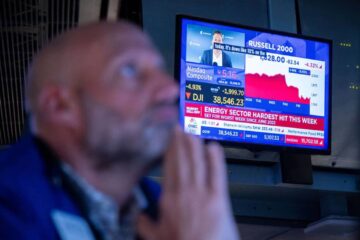Wall Street isn’t likely to get any near-term relief from yesterday’s $1.5 trillion sell-off, the worst in two years, as stock futures move lower again in pre-market trading.
U.S. equity futures moved sharply lower Thursday, following on from Wall Street’s biggest single-day decline in nearly two years, as global markets wilt under the pressure of surging inflation, slowing growth and aggressive central bank rate hikes signaling.
Stocks have also been jolted by a series of warnings from blue-chip retailers, including Target (TGT) – Get Target Corporation Report and Walmart (WMT) – Get Walmart Inc. Report, that rising fuel and labor costs, as well as mis-timed inventory builds, will pressure near-term profit margins. Each of the country’s two largest retailers suffered their biggest single-day declines since 1987 this week, with Target losing around a quarter of its value in yesterday’s carnage.
The moves, as well as bets on faster rate hikes from the Fed, have the S&P 500 on pace for the biggest weekly slump in more than a decade and, 95 trading days in, its second-worst start to any trading year since 1932.
The Fed, for its part, has said it won’t deter from rate hike path until there is “clear and convincing” evidence that inflation is slowing, according to comments earlier this week from Chairman Jerome Powell.
Rate traders are still pricing in a 85% chance of a 50 basis point hike next month, according to the CME Group’s FedWatch tool, as well as an 84.7% chance of a similar move in July, even as benchmark 10-year Treasury bond yields slump to 2.832% in the overnight session — down from around 3.19% early last week — and the dollar index fell 0.24% against a basket of six global currencies to 103.55 in early European trading.
The market’s key volatility gauge, the VIX, is also on the rise, gaining 22.2% in the early trading session to 31.88 points, suggesting another day of wild swings for Wall Street is on the cards.
“The stock market will remain in purgatory until the Federal Reserve smothers the inflationary wildfire with higher interest rates that cool consumer demand for goods, services, houses and hotel rooms,” said Ryan Belanger, managing principal and founder of Boston-based Claro Advisors.
Stocks Extend Slump, Cisco, Under Armour, Tesla And Boeing In Focus – Five Things To Know
“Investors should become accustomed to significant downside and upside moves in stocks, which is common during times of tremendous uncertainty,” he added. “We expect the stock market to trade near or in bear market territory for the coming months, creating a frustrating range-bound market that will test the will of many investors.”
On Wall Street, futures tied to the Dow Jones Industrial Average indicating a 270 point opening bell decline while those linked the S&P 500, which is down 18.2% for the year, are priced for a 34 point move to the downside Futures linked to the Nasdaq are looking at 110 point opening bell slump, pulling the tech-focused benchmark into a year-to-date decline of around 30%.
In terms of individual stocks, Cisco Systems (CSCO) – Get Cisco Systems, Inc. Report shares slumped 11% after the world’s biggest computer network equipment maker posted weaker-than-expected third quarter sales, and forecast softer near-term profits, thanks in part to supply chain disruptions that are holding back deliveries of key components.
BJ’s Wholesale Club (BJ) – Get BJ’s Wholesale Club Holdings, Inc. Report, however, rose 5% after it posted stronger-than-expected first quarter earnings while keeping a lid on cost increases that plagued profit updates from retailing giants Target and Walmart.
Boeing (BA) – Get Boeing Company Report shares moved 0.5% lower, but found support from news of a major aircraft order from British Airways parent IAG worth around $6.25 billion.
Under Armour (UAA) – Get Under Armour, Inc. Class A Report shares moved 3% lower in pre-market trading after the sports apparel group said CEO Patrick Frisk will step down from his role at the end of the month.


